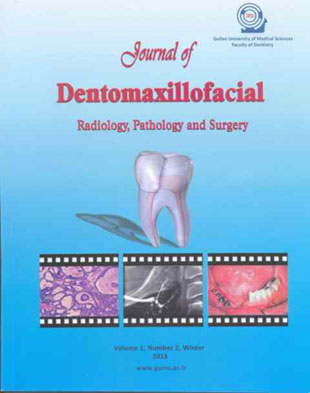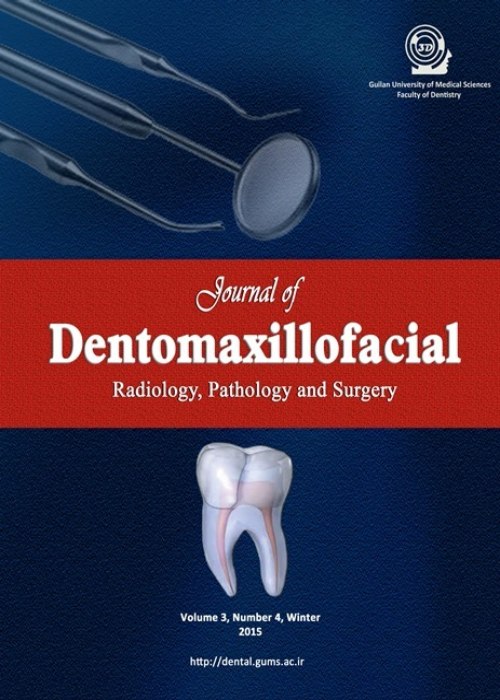فهرست مطالب

Journal of Dentomaxillofacil Radiology, Pathology and Surgery
Volume:2 Issue: 3, autumn 2013
- تاریخ انتشار: 1392/09/24
- تعداد عناوین: 6
-
-
Pages 1-7IntroductionThe main purpose of this study is to evaluate the radiopacity of composites on the market with digital radiography.Materials And MethodsIn this experimental in vitro research, eight composite resins which are commercially available and commonly used were evaluated. Each composite sample with aluminum step wedge and tooth section were positioned over a phosphor plate, radiographed and compared with standard.Resultswe have to compare the mean values of different types of composite materials with values of dentine and enamel using Mann-U Whitney test with significance of p=0.01. The radiopacity of composites ranged from 78.8±0.83mm Al (Tetric N Ceram) to 16±0.7mm Al (Gradia Direct).ConclusionMost of the tested composite ma-terials fulfill the requested criteria for radiopaci ty with a few exceptions. The opacity of Tetric N Ceram Z is 250; Tetric N flow and opallis flow are point 4. Permis formula was higher than enamel and is standard. Aeliteflo had similar opacity to dentin and is also standard.Keywords: Dental Digital Radiograghy, Dental Materials, Composite Resins
-
Pages 8-16IntroductionThis study aims at examining the difference of pharyngeal airways in patients with different occlusion postures, hoping to im prove diagnostic methods and provide a stable treatment plan for orthodontic patients.Materials And MethodsThe data were ga-thered through CBCT radiographies of patients from a specialized center for radiology. In each occlusion group according to the performed pilot study, 30 people (90 people in 3 groups of class I, II and III, male and female each) were chosen as the sample. The two-di mentional cephalometric radiographs were ob tained from 3D-radio-graphs, and the patients’ malocclusion postures were de termined according overjet and ANB angle, and finally grouped. Next, airway volume and di mensions were measured in cross sectional.ResultsStatistical studies showed there is a significant relationship between anteroposte-rior positions of mandible and the volume of pharyngeal airway. Also, the volume of pharyn-geal airway in class III patients is more than those of patients in class I. The volume of pha-ryngeal airway in class II patients is also less than those of class1 patients.ConclusionPharyngeal airway in class III is larger and in class II smaller. Therefore, consi-dering this subject can lead to improving diag-nostic ways, especially orthognatic surgery treatments, and providing a stable treatment plan for patients who need orthodentic treat-mentKeywords: Airway volume, Pharengeal airway, Cone, Beam Computed Tomography (CBCT)
-
Pages 17-20IntroductionPeripheral odontogenic tumors are rare and there is no valid information of the frequency of them in the literature. This study aims to obtain the frequency of these tumors.Materials And MethodsThe files of oral and maxillofacial pathology (microscopic reports and slides), faculty of dentistry, Shahid Beheshti University of medical sciences served as the source of the material during a 20-year-period for this retrospective,descriptive cross-sectional study. Clinical information including, patient’s age, gender and location was record-ed.ResultsThree hundred seventy nine cases of odontogenic tumors were assessed in which 16 cases (4.22%) were peripheral and 363 cases (95.77%) central. Peripheral odontogenic fibroma was the most common case of the 16 peripherals accounting for 10 cases (62.5%) followed by peripheral ameloblastoma(25%) and peripheral dentinogenic ghost cell tumor (12.5%). The peripheral type of odontogenic fibroma was more common than central counterpart (3.3:1).ConclusionIn our study, similar to the previous ones, the relative frequency of the peripheral odontogenic tumors was low and peripheral odontogenic fibroma was the most common tumor among other peripheral subtypes. Unlike other types, the incidence of peripheral odontogenic fibroma was higher than the central odontogenic fibroma.Keywords: Odontogenic Tumor, Jaw Neoplasm, Peripheral, Histopathology
-
Pages 21-25IntroductionRegarding the cross contamina-tion, prevention from infection is of high prior ity. The aim of this research was assessment of knowledge and attitude of dental students toward infection control in endodontics depart ment of faculty of dentistry, Babol Uni versity of medi cal sciences.Materials And MethodsThe study was accom plished among 8th, 10th and 12th grade dental students in endodontics department during Oc tober-January, 2011. The student''s knowledge and attitude towards infection control were in vestigated. The range of knowledge score was 8 to 19. The scores below 14 were considered low and between14 to 17 moderate and higher than 17 good. The attitude questions also in cluded 3 answers (agree, disagree and have no idea). Their scores were -1, 0 and 1. The range of atti tude score was -6 to 8. The scores below -2 were con sidered low and between -2 to 2 moderate and higher than 2 good. Data were collected via questionnaire and analyzed statisti cally using One-Way ANOVA, and HSD Tukey.ResultsThere was no significant difference between men (15.45±2.85) and women know ledge (15.2±2.7) (P=0.65) and attitude (0.2±2.5 vs. 0.35±2.49) (P=0.5). The difference between 8th and 12th semester was statistically significant (p=0.026). There was no significant difference between different semesters in attitude (p=0.94).ConclusionThis study revealed that knowledge and attitude of Babol Dental School toward in fection control is not adequate and more training in both educational and practical fields is re quired.Keywords: Infection control, Dentistry health service, Infectious disease
-
Pages 26-33IntroductionPeriodontal disease, an inflamma- tory and infectious disease in adults and anemia associated with chronic infection, is one of the most common types of anemia. Considering the similarity of pathogens causing periodontal dis ease and anemia, this study aims to investigate the correlation between hematologic para meters associated with anemia and modera te chronic periodontitis.Materials And MethodsThis case-control study was systematically performed on blood samples of 60 healthy men. The control group consisted of 30 men who had healthy periodontium and the case group included 30 men with moderate chronic periodontitis. Clinical examination of patients was done using Wil liams periodontal probe and assessment of CAL, PPD, BOP and GI. Blood samples were collected at the Depart- ment of Periodontology, Babol school of Dentistry and evaluation of red Erythrocyte indices, Hemoglobin, Hematocrit, SI and TIBC was done. Data collected from clinical examinations and labor atory tests were analyzed by T-test, Pearson correla tion coefficient and Spearman tests.ResultsReduction of MCV, MCH, Hb, HCT, SI and TIBC factors were observed with increasing GI and CAL and BOP. There is no significant cor rela tion between GI and CAL and BOP and MCHC fac tor. No Significant correlation exists between PPD changes and hematological factors associated with anemia.ConclusionA correlation was observed between some hematological parameters asso ciated with ane mia and moderate chronic peri odontitis.Keywords: Anemia, Periodontitis, Iron, Hemoglobin, Erythrocyteindices
-
Pages 34-39IntroductionDentin dysplasia is a rare autosomal dominant inheriting disturbance of dentin formation characterized by normal enamel formation, but atypical dentin with abnormal pulpal morphology. There are two major patterns: type I and type II. Amelogenesis imperfecta is an autosomal dominant. X-link inherent disease that is classified by clinical manifestation into hypoplastic, hypomature, hypocalcified. The simultaneous occurrence of dentin dysplasia and amelogenesis imperfecta is quite rare. The purpose of this case report is to pre-sent a case of dentin dysplasia type I which is also associated with hypoplastic amelogenesis imperfecta in an 18 year old girl, without any syndromic signs.Keywords: Dentin dysplasia, Amelogenesis imperfecta, Dental anomalies


